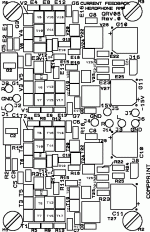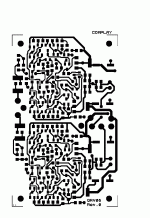Realy nice work Per, but I have question : have you any phones with similar wide frequency ? Was your grandfather dolphin and your father bat ? Have you " sonar " ears ? Will be sound produced by this amp pleasant for guys which have " glass cathode head " ? 😎
Regarding frequency range - less is sometimes more. DC - 100kHz might give better sonic results than DC - 20 MHz, once you'll see and hear 😉 , as you do not need to listen to RF intermodulation products.
But for short wave transmitter, DC - 20 MHz will definitely give better result 😉
But for short wave transmitter, DC - 20 MHz will definitely give better result 😉
kilometers Per hour
Here's some Gain Bandwith products for some of the most popular op amps among
the DIY builders:
OPA627 16MHz
OPA604 20MHz
AD8610 25MHz
AD825 41MHz
OPA627 >50MHz
I think Per is probably in the neighborhood of a reasonable bandwidth. It sounds like a good idea to me.........
Here's some Gain Bandwith products for some of the most popular op amps among
the DIY builders:
OPA627 16MHz
OPA604 20MHz
AD8610 25MHz
AD825 41MHz
OPA627 >50MHz
I think Per is probably in the neighborhood of a reasonable bandwidth. It sounds like a good idea to me.........
Re: kilometers Per hour


If you (not Fred) check the shematics you have a "speed adjuster" so you can tune in the speed you like but the main purpose is to get a stable amp.
Don't forget that we have a bunch of guys here which like current feedback opamps with speed of > 100 MHz => GHz transistors.
What?Fred Dieckmann said:I think Per is probably in the neighborhood of a reasonable bandwidth. It sounds like a good idea to me.........


If you (not Fred) check the shematics you have a "speed adjuster" so you can tune in the speed you like but the main purpose is to get a stable amp.
Don't forget that we have a bunch of guys here which like current feedback opamps with speed of > 100 MHz => GHz transistors.
Peranders
This is serious!
Please explain to me the advantages of having audio gear that are able to reproduce 20MGHz and up.....
The harmonics are "long gone" at that frequency!!!!!
This is serious!
Please explain to me the advantages of having audio gear that are able to reproduce 20MGHz and up.....
The harmonics are "long gone" at that frequency!!!!!
Speed
Per, you have certainly true - ultra fast stabil amp will have low distortion on high frequecys and it is right, but read again words of PMA - ultrawide frequency band is not in some cases the best solution.
Per, you have certainly true - ultra fast stabil amp will have low distortion on high frequecys and it is right, but read again words of PMA - ultrawide frequency band is not in some cases the best solution.
Re: Speed
Pcb's are ordered in case any wonders...
Maybe so, but I (or anyone else) can adjust that. Faster isn't automaticly better but building the prototype will give us the answers but I have a hunch about linearity and high speed. Normally this is positive.Upupa Epops said:...ultrawide frequency band is not in some cases the best solution.
Pcb's are ordered in case any wonders...
Re: kilometers Per hour
Fred, there's 2 OPA627. The 16MHz one is correct, but the other... maybe an OPA637?
Fred Dieckmann said:Here's some Gain Bandwith products for some of the most popular op amps among
the DIY builders:
OPA627 16MHz
OPA604 20MHz
AD8610 25MHz
AD825 41MHz
OPA627 >50MHz
I think Per is probably in the neighborhood of a reasonable bandwidth. It sounds like a good idea to me.........
Fred, there's 2 OPA627. The 16MHz one is correct, but the other... maybe an OPA637?
Re: Peranders
Hugh (and his many customers) on the other hand thinks that his rather slow AKSA amp is sounding good so there you have the opposites. I will come back later and tell you if 20 megagigaherts(!) is good or bad soundwise.
Sorry, Jan, I can't. First of all it's a thrill technically to scream out 20 MHz with gain from plain BC-transistors.ACD said:This is serious!
Please explain to me the advantages of having audio gear that are able to reproduce 20MGHz and up.....
The harmonics are "long gone" at that frequency!!!!!
Hugh (and his many customers) on the other hand thinks that his rather slow AKSA amp is sounding good so there you have the opposites. I will come back later and tell you if 20 megagigaherts(!) is good or bad soundwise.
Re: Re: Speed
Yes, inherently fast and stable is good, but impulse response unfortunatelly tells nothing about intermodulation with D/A HF residuals. We have compared "unlimited" buffer-preamp (about 6MHz/-3dB) with filtered version (about 140 kHz/-3dB) and the final judge was clear - everyone of 10 listeners preferred the bandwidth limited version. Cleaner, less agresive, non-harsh, more details, more natural sound.
peranders said:
Maybe so, but I (or anyone else) can adjust that. Faster isn't automaticly better but building the prototype will give us the answers but I have a hunch about linearity and high speed. Normally this is positive.
Pcb's are ordered in case any wonders...
Yes, inherently fast and stable is good, but impulse response unfortunatelly tells nothing about intermodulation with D/A HF residuals. We have compared "unlimited" buffer-preamp (about 6MHz/-3dB) with filtered version (about 140 kHz/-3dB) and the final judge was clear - everyone of 10 listeners preferred the bandwidth limited version. Cleaner, less agresive, non-harsh, more details, more natural sound.
Per, it is all about " fine tuning " of final product - I hope that you will inform us about this hearing experiences . Last arbiter is human ear, but it must be ears of guys, which have not " glass head " 🙂 .
I was one of this ten listeners - results was quite convincing, but I must say, that I have not " glass head " 😎 - for this guys are all frequencys over 20 kHz " dangerous " - for me it start over about 500 kHz 😀 .
Some is paying attention....
"Fred, there's 2 OPA627. The 16MHz one is correct, but the other... maybe an OPA637?"
Yes indeed. thanks for the heads up.
"Fred, there's 2 OPA627. The 16MHz one is correct, but the other... maybe an OPA637?"
Yes indeed. thanks for the heads up.
Even if it does work to 20 MHz.........
You still need to limit out-of-band signals!!!!! Nothng magical about that, just plain common sense engineering.
Jocko
You still need to limit out-of-band signals!!!!! Nothng magical about that, just plain common sense engineering.
Jocko
I would say, that this is one nice CFP amp.
The bandwidth is just fine.
Of course you need to limit the bandwidth with a LF filter in the input. ... lets say to 200KHz, but with this large bandwidth his amp has nearly the same distortion spectrum at 20k as at 1k. I think this is one parameter we all would like to get....
The ear is very sensitive to harmonics in its "window"....
Sonny
The bandwidth is just fine.
Of course you need to limit the bandwidth with a LF filter in the input. ... lets say to 200KHz, but with this large bandwidth his amp has nearly the same distortion spectrum at 20k as at 1k. I think this is one parameter we all would like to get....
The ear is very sensitive to harmonics in its "window"....
Sonny
Re: Re: Re: Speed
My theory is to have a fast circuit BUT limit the incomning signal with a plain LP-filter at a sufficiently high frequency.
The amp we talk about here has also a input filter as every amp have which I have designed. This is just common pratice I think.
The design is very easy to adjust when in comes to speed and current consumption.
Listen up guys which remove the output filter of DAC's! The garbage from a DAC _can_ be audiable. If you happen to have a unit which produces unwanted (out of band) signals you should block these signals instread of creating circuits which can make them pass further in the chain.PMA said:
Yes, inherently fast and stable is good, but impulse response unfortunatelly tells nothing about intermodulation with D/A HF residuals.
The reasons for this "bad" sound can be that high frequency residuals produces audiable "garbage".PMA said:We have compared "unlimited" buffer-preamp (about 6MHz/-3dB) with filtered version (about 140 kHz/-3dB) and the final judge was clear - everyone of 10 listeners preferred the bandwidth limited version. Cleaner, less agresive, non-harsh, more details, more natural sound.
My theory is to have a fast circuit BUT limit the incomning signal with a plain LP-filter at a sufficiently high frequency.
The amp we talk about here has also a input filter as every amp have which I have designed. This is just common pratice I think.
The design is very easy to adjust when in comes to speed and current consumption.
- Status
- Not open for further replies.
- Home
- Amplifiers
- Headphone Systems
- Current feedback high speed headphone amp with diamond output buffer

